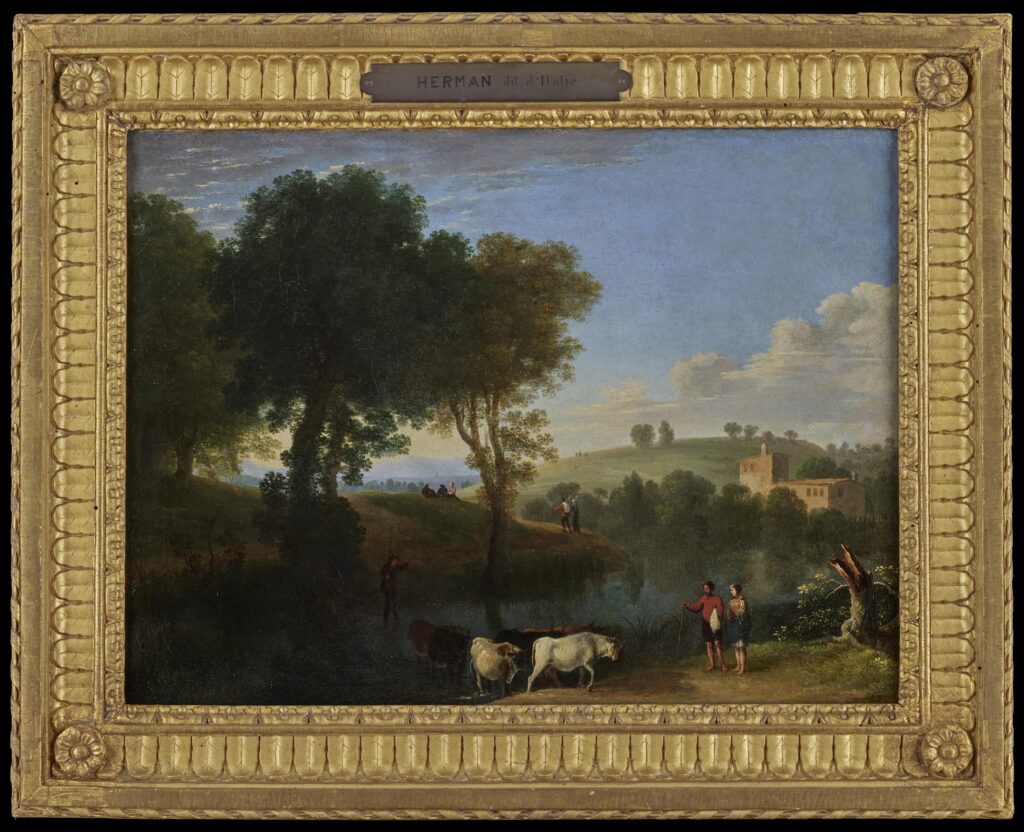Herman Van Swanevelt
1604 – 1655
A Landscape with Shepherds and Cows fording a River

Medium:
Oil on Canvas
Category:
Dimensions:
36.5(h) x 47(w) cms
Framed Dimensions:
47(h) x 59(w) cms
Essay:
Little is known about the early career of the Dutch Italianate painter Herman van Swanevelt. Born probably in Woerden in about 1603, he is recorded as being in Paris in 1623. In France he met relatives of his mother, who was a granddaughter of the famous painter Lucas van Leyden. It is not known when he left for Rome, where he is recorded in 1627/1628 by his friend Giovanni del Campo, who stated in February 1637 that he had known Swanevelt for nine years. In Rome he lived in a house in the parish of San Giuseppe a Capo le Case together with other artists. He became a member of the 'Bentvueghels', the unofficial community of the Dutch and Flemish artists in Rome (where he acquired the nickname ‘hermit’), as well as a member of the official Accademia di San Luca. Because his name was difficult to pronounce and spell by Italians, he usually was called ‘Monsieur Armanno’ or ‘Monsù Armanno’.
In 1633/ 1634, both he and Claude Lorrain, who was of the same age as Swanevelt, painted the first “revolutionary” pictures, showing the sunlight of a fresh morning, of a warm afternoon or a glowing evening sky. The light bathes the whole landscape, spreading from the horizon towards the shadowy foreground, where only the figures and some details are hit by sunlight. In Rome, Swanevelt produced a series of decorative paintings for Cardinal Antonio Barberini, nephew of Pope Urban VIII, as well as for El Buen Retiro, one of the palaces of the Spanish King Philip IV. He also painted four fresco-friezes in the Palazzo Pamphilj in Piazza Navona for Cardinal Giambattista Pamphilj, (after 1644 Pope Innocence X), and two frescoes in the vestry of S. Maria sopra Minerva in 1634 (only one now remains). His Roman pictures are extremely atmospheric and most of them, in keeping with the halls in Roman palaces, are of a rather large size. They are often filled with biblical, mythological or arcadian figures. His last dated Roman work is a drawing (London, Courtauld Galleries, inv. no. 4483), signed with monogram and dated “RO. / 1641”. In March 1641 he received a payment from Cardinal Antonio Barberini and he evidently left Rome soon afterwards for Florence. Subsequent inscribed paintings and drawings suggest that he was also in Venice in 1642 and in Woerden again in 1644.
By 1643 Swanevelt was back in Paris, where he stayed until his death in 1655. He left Paris several times to visit his family in Woerden and once in 1649 for a short stay in Rome. In 1644 a first marriage contract is mentioned. He did not go through with the marriage, probably due to the controversy surrounding a marriage between a Protestant and a Catholic. In the same year he was elected ‘peintre ordinaire du Roi’. In 1650 he married Suzanne Rousseau from a Protestant family, the sister of his pupil Jacques Rousseau. Also in 1650, he obtained royal permission to publish his etchings, most of which were produced in Paris. Swanevelt is known to have been very successful in Paris and he generously provided loans to a number of individuals, the majority of which had not been repaid at the time of his death. The inventory of his estate of 1657 shows that he died a wealthy man, leaving behind his young wife and a daughter called Judith. In Paris he lived in two different places in the parish of St. Nicolas-des-Champs and was known as ‘Monsieur Armand’, later as ‘Herman d’Italie’. It would appear that he never had a studio with assistants and pupils, neither in Rome, nor in Paris. M. Szanto argues, that “it seems obvious, that Swanevelt [in Paris] wished to control his reputation by personally managing the distribution of his works, be they painted or engraved.” (See: M. Szanto, Burlington Magazine, C XLV (2003), no. 1200, p. 199 – 205). The same seems to have been true while he worked in Rome.
About 1646 Swanevelt participated in the decoration of the Cabinet de l’Amour in the Hôtel de Lambert de Thorigny together with other painters, one of whom was Jan Asselijn, who left Paris before August 1646. During his years in Paris he worked for wealthy and influential art collectors. Most of these commissions are smaller, adjusted to the size of rooms in Parisian houses, and are filled with herdsmen and -women, peasants and travellers.
Interestingly, Swanevelt was not a pupil of Claude, as literature has claimed for centuries. Although Swanevelt is less well known than Claude, he was nevertheless a most influential innovator in landscape painting, a successful painter, who worked for the most prominent art connoisseurs and collectors of his lifetime, one of the best Italianate draughtsmen and a famous etcher, whose etchings helped spread his new ideas and were sought after right up to the time of Goethe.
We are very grateful to Anne Charlotte Steland for her help in writing this entry.
-
A label au verso reads "Paysage uen riviere, des vaches, des paysand, par Herman d'Italie" and the stretcher bears the number 39.
Provenance:
Collection of Marquis de Calvière (1693 - 1777), Chateau de Vézénobres, France;
Private collection, France.